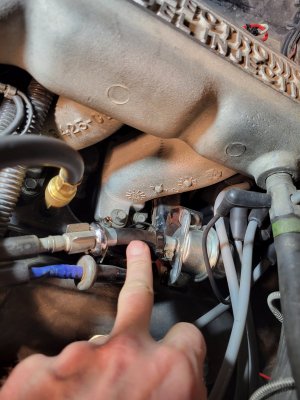Did I mention we've been at this for more than a year?
Did I mention on more than one occasion we end up following the same (basic) troubleshooting steps because the same symptoms appear?
Feels like a game of whack-a-mole...and after a while it's no longer fun. (Keep your sense of humor Jack

)
I did mention that 2 weeks ago fuel pressure was between 35-40psi, right?

Fuel pressure: 0 psi just now.
I have to ground the Tan/lg wire at the diag connector, so that when the key is on the pump runs. (We'll fix that after it starts)
Yes, I hear the High-pressure and low-pressure pumps running.
Yes, I confirmed the pressure gauge is working on one of the tire's Schrader valves.
Yes, fresh gas was added a few weeks ago, so the tank isn't dry either. (still some stale fuel? Yes)
This is actually good news!
Since we've been here before, I'll go back to basic troubleshooting by removing sections of the fuel line between the tank and fuel rail.
(Fuel filter? clogged line? FPR?)
I also borrowed a noid light set, so I can test the FI 'the right way'.
Progress!
I read through most of this thread, (I read you've been at it a year,) and someone may have already mentioned all of these things, but read it through-it may spark another idea.
It really sounds as though the main issue is electrical, and that its intermittently affecting the ignition system. (Intermittent is often a sneaky bitch.) When focussing on a specific problem area its easy to overlook basics.
Maybe a step back and some rethinking is in order.
Your B2 is over 30 years old, so preventative maintenance stopped a long time ago, and everything on the vehicle was an in an unknown state when you got the vehicle, so the probablility that nothing is working OPTIMALLY is something to keep mind. (You're now in the unhappy position of hoping for the best without necessarily wanting to catch up for all maintenance that was NOT done through the years.)
Definitely basic, but have you gone through the vehicle and CLEANED/BURNISHED ALL the ground and power connections you can access, taking apart ALL the electrical connectors- those in the engine compartment for a start. And any self grounded components too Then all those under the dash, and the ICM. Then the fuel pump grounds. (If a circuit ground is weak sometimes the current will find a different/better grounding point where it should NOT be connected and in doing that, can affect other unrelated circuits.)
Sometimes thermal expansion can cause a ground OR power connection to become EITHER looser or tighter, and if one is already marginal connected or partially corroded, a couple thousandths of an inch can make all the difference. And rain or high humidity can sometimes make a bad ground or power connection better, but the saem connection can revert to intermittent or bad once it dries out-such as after the engine has run for a while. And don't just take connectors apart, after they are clean and while they are open use some dielectrical grease so you won't have to go back trying to find the ONE that oxidizes AFTER you checked it. (The turn signals, side indicators, headlights and stop lights are particularly vulnerable to corrosion.)
One ground that's often overlooked is the body to frame one, a flat bare strap that's below the heater housing. Another is the OEM one piece ground cable assembly that not only bolts to the frame, but has a pigtail going to the wiring harness at that point and the main cable continues to the starter. That pigtail can cause havoc if it isn't grounded.
You mentioned the distributor being replaced.
Was it new or remanufactured?
Was the ignition module replaced too?
(Don't rule out even a new module-that could be bad/intermittent straight from the box.)
(Also starter solenoids can malfunction from the get go.)
This distributor location makes it subject to overheating which has sent millions of distributor mounted Ford ignition modules to an early grave. (MOST OFTEN the modules don't fail entirely, but begin their downward spiral by acting erratically, causing intermittant ignition problems, such as sudden COMPLETE ignition failure followed by working properly again once cooled down. ( It wouldn't hurt to make sure the protective grease is between the module and the distributor.)
Another maddening possibility is the TPS, which, like the ignition module, is well known to NOT to fail entirely, (and is also subject to intermittent heat-related failure, then works after cooling down) but often starts acting erratically or, interestingly, sometimes develops a "flat spot" where its signal strength suddenly drops off at a specific accelerator position or rpm and whose signal then resumes increasing instead of smoothly and steadily increasing as you press the accellerator further through its travel.
Of course the spark plug wires, especially the distributor to coil wire if old or oil soaked.
The ignition switch, neutral safety switch, a weak or bad connection AT the fuse block, all are basic items to check. (They have probably all been.)
PS, the distrbutor itself can contribute to the problem if its cap is carbon tracking .


